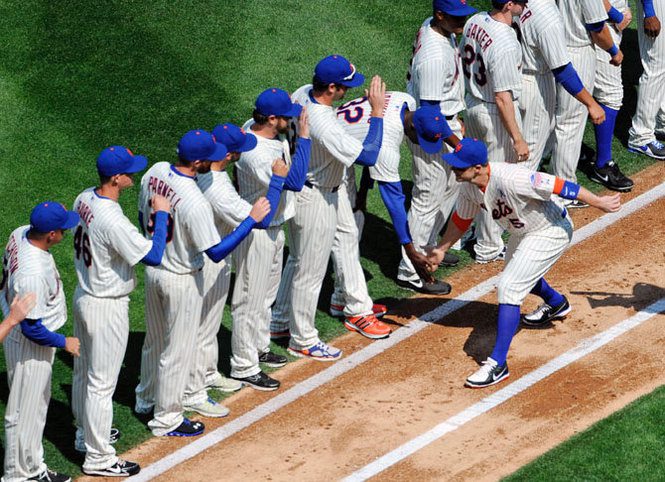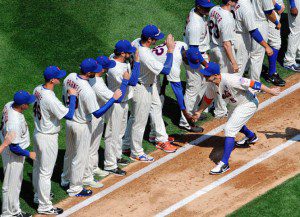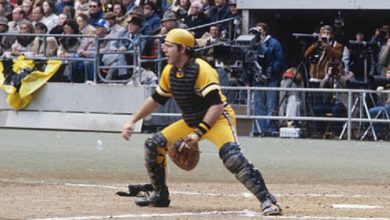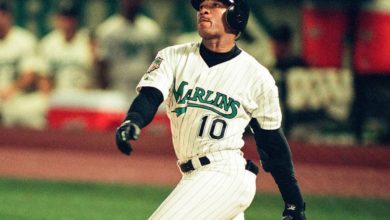

As the season draws to a close, the New York Mets have had a season that, while disappointing once again, has shown signs of a promising future. They’ve showcased exciting young pitchers, brought up promising youngsters from the minor leagues, and battled hard despite losing a lot of their most dependable players to injury or transaction. Management has declared its willingness to make significant moves in this coming offseason, and the Mets have some interesting trade bait they can package to land an established, high-impact player.
However, they should bear in mind that it’s important to keep some building blocks in place, especially ones cultivated within the organization. The New York Mets’ foundation is solid, but the trick is knowing which prospects to keep, which ones to sell high and which ones are worth sacrificing for a known quantity.
Below are a few players the Mets should consider part of their working core, from which to build around between now and 2014:
David Wright, 3B — This one’s a no-brainer. In his age-30 season, the Mets’ captain has finally synthesized into a complete player who can be a true centerpiece. He still makes the spectacular plays that have won him Gold Gloves in the past, but he’s also gotten rid of the throwing yips that made Carlos Delgado work so hard at times. At the plate, he’s mostly settled into his best self: a line-drive hitter with intermediate home run power who uses the entire field and drives the ball into the opposing gap. He’s a true keeper, and still solidly in his peak years.
Juan Lagares, CF — Defensive center fielders like Juan Lagares don’t come around very often, especially if you consider that he’s got a right-field type of arm. Despite not landing an everyday job until well into the season, Lagares is at the top of the Major League leaderboard in outfield assists, and his tracking ability is stunning. His off-the-bat reads seem almost precognitive, and because he goes back on the ball so well, he can play shallow enough to steal soft liners and Texas-leaguers. The strength of his arm might lend itself to the suggestion that Lagares be moved to right field, especially since Matt den Dekker is also a good defensive center fielder. In my opinion, this would be tinkering with possible greatness. When you luck into a center fielder who’s defensively reminiscent of a young Andruw Jones, you thank your lucky stars and leave him where he is. If Lagares levels off into a consistent hitter, he could occupy the 2-hole in the lineup. If not, bat him seventh and let him keep the opposition’s runs off the scoreboard with his defense.
Bobby Parnell, Closer — I’ve already mentioned in a previous article why I think too many people underestimate the importance of a standout closer. Not only is Bobby Parnell showing signs of being a true closer instead of a flash in the pan, but he’s come a long way while in the Mets organization. Homegrown talent is important to build around, because it cultivates loyalty. The Mets rode through Parnell’s growing pains, and now he’s a legitimate game-shortener who has lights-out velocity and is learning the craft of pitching instead of just throwing hard when in trouble. They should hang on to him.
Jon Niese, SP — Every good pitching rotation needs a good lefty, and every good pitching rotation needs a guy who can dig his way out of trouble. In Jonathon Niese, the Mets have both. Niese has worked through some rough patches and injuries, and has become a guy who combines a sneaky swing-and-miss curveball with an ability to keep things from getting out of hand when he isn’t locked in. He’s the Mets’ version of Andy Pettite (calm down, Yankee fans, I’m not saying he’s a Hall of Fame just yet), and they should aim to keep him.
Jenrry Mejia, SP — Jenrry Mejia has been a well-regarded prospect for some time, though he’s still very young. His trajectory has been a bit jagged, struggling with his control at times and battling through arm troubles that culminated in surgery to remove bone spurs from his throwing elbow. Yet despite pitching through considerable discomfort, Mejia turned a corner in 2013. His command improved, and he learned to sequence his pitches to keep hitters off balance when he didn’t have his best stuff. He battled through tough innings, and showed increased confidence and composure. His air of calm on the mound belies his years, and with that kind of composure he can harness his high-level stuff to be a top-rotation pitcher.
Lucas Duda, 1B — First of all, in the interest of full disclosure I must confess to having spent much of 2011 on the Ike Davis bandwagon. As many of you know, I’ve seen the error of my ways in this regard, and now regard Davis as an erratic, temperamental, maddening player who belongs in a small ballpark as a secondary all-or-nothing slugger. But I digress somewhat. I have come to believe, as of late last season, that Lucas Duda is a more complete hitter than Davis, and just as powerful. He’s shown signs that he’s capable of being a decent cleanup presence when he’s left to play his natural defensive position. The fact is, despite loads of hard work and some visible improvement, Duda never became more than a mediocre outfielder–and in the spacious, difficult Citi Field outfield, his fielding deficiencies were constantly exposed. This seemed to affect him at the plate, where he seemed to struggle to make up for his defense, using less of the field and swinging harder and less selectively.
The thing that makes Duda so dangerous is that he’s capable of hitting the ball up the middle and to the left side when needed, making him more than a one-dimensional threat. He’s also got a good eye at the plate, and is willing to take walks, which means he’s not a guy you can strike out with waste pitches. His defense as first is decidedly middling, but he’s capable of the occasional game-saving scoop and he isn’t a liability. Most importantly, when he plays first base, he hits. Not everyone is a ‘Swiss Army Knife’ you can just plug in anywhere, and it can’t be held against Duda that he has a hard time in the outfield. Put him where he’s comfortable, let him relax and stop trying so hard to make up for his defense, and he has a chance of being a dangerous, situationally sound cleanup hitter. With a bit of lineup protection, and hitting behind David Wright, I think Duda can hit .275-.280 with 25 home runs and a good number of doubles–think of the season Marlon Byrd just gave us, with a bit more home run power. If the Mets can land a big bat for some protection, Duda will flourish.
The New York Mets are definitely in a transitional period, with developing strengths and holes to fill. How they manage this offseason will go a long way toward determining how soon they get over the hump. Knowing which pieces belong as part of the core is a big step.
*Note: I did not mention Matt Harvey in this list, because of the middling chance that he will heed the advice of many–myself included–and just have the Tommy John surgery, get his arm totally right, and come back in 2015 as the franchise ace he’s well on his way to becoming.





